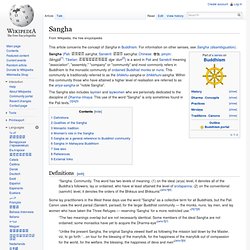

Sangha. Sangha (Pali: सङ्घ saṅgha; Sanskrit: संघ saṃgha; Chinese: 僧伽; pinyin: Sēngjiā[1]; Tibetan: དགེ་འདུན་ dge 'dun[2]) is a word in Pali and Sanskrit meaning "association", "assembly," "company" or "community" and most commonly refers in Buddhism to the monastic community of ordained Buddhist monks or nuns.

This community is traditionally referred to as the bhikkhu-sangha or bhikkhuni-sangha. Within this community those who have attained a higher level of realisation are referred to as the ariya-sangha or "noble Sangha". The Sangha also includes laymen and laywomen who are personally dedicated to the discipline of Dharma-Vinaya. This use of the word "Sangha" is only sometimes found in the Pali texts.[3][4][5] Definitions[edit] “Sangha.
“The two meanings overlap but are not necessarily identical. Qualities of the Sangha[edit] The Sangha: The Sangha of the Blessed One's disciples (Savakas) is: Monastic tradition[edit] Women's role in the Sangha[edit] An almsbowl used by members of the Sangha. Sthaviravada. Sthaviravāda (Sanskrit: स्थविरवाद; traditional Chinese: 上座部; pinyin: Shàngzuò Bù) literally "Teaching Of The Elders", was one of the early Buddhist schools.

It was one of the two main movements in early Buddhism that arose from the Great Schism in pre-sectarian Buddhism, the other being that of the Mahāsāṃghika school. Scholarly views[edit] Origin[edit] Most sources place the origin of the Sthaviras to the Second Buddhist council. Traditions regarding the Second Council are confusing and ambiguous, but it is agreed that the overall result was the first schism in the Saṃgha, between the Sthaviras and the Mahāsāṃghikas, although it is not agreed upon by all what the cause of this split was.[1] Language[edit] The Tibetan historian Buton Rinchen Drub wrote that the Mahāsāṃghikas used Prākrit, the Sarvāstivādins used Sanskrit, the Sthaviravāda used Paiśācī, and the Saṃmatīya used Apabhraṃśa.[6] Legacy[edit] The Sthaviras later divided into other schools such as: Relationship to Theravāda[edit]
Mahāsāṃghika. Lions from Sāñchī, where the Caitika Mahāsāṃghika sub-sect was preeminent The Mahāsāṃghika (Sanskrit: महासांघिक mahāsāṃghika; traditional Chinese: 大眾部; pinyin: Dàzhòng Bù), literally the "Great Saṃgha," was one of the early Buddhist schools in ancient India.

One reason for the interest in the origins of the Mahāsāṃghika school is that their Vinaya recension appears in several ways to represent an older redaction overall. Many scholars also look to the Mahāsāṃghika branch for the initial development of Mahāyāna Buddhism.[1] Location[edit] The original center of the Mahāsāṃghika sect was in Magadha, but they also maintained important centers such as in Mathura and Karli.[2] The Kukkuṭikas were situated in eastern India around Vārāṇasī and Pāṭaliputra.[3] The Ekavyahāraka and Lokottaravāda subschools were found near Peshawar around 200 BCE, and the Bahuśrutīya in Kośala. The Caitika branch was based in the Āndhra region and especially at Amarāvati and Nāgārjunakoṇḍā. Theravada. Theravāda (Sanskrit: स्थविरवाद) is a branch of Buddhism that uses the teaching of the Pāli Canon, a collection of the oldest recorded Buddhist texts, as its doctrinal core, but also includes a rich diversity of traditions and practices that have developed over its long history of interactions with various cultures and communities.

It is the dominant form of religion in Cambodia, Laos, Sri Lanka, Thailand, and Burma, and is practiced by minority groups in Vietnam, Bangladesh, and China. In addition, the diaspora of all of these groups as well as converts around the world practice Theravāda Buddhism. Adherents[edit] Theravāda Buddhism is followed by various countries and people around the globe, and are: Today, Theravāda Buddhists, otherwise known as Theravadins, number over 150 million worldwide, and during the past few decades Theravāda Buddhism has begun to take root in the West[a] and in the Buddhist revival in India. History[edit] Origins[edit] Transmission to Sri Lanka[edit]